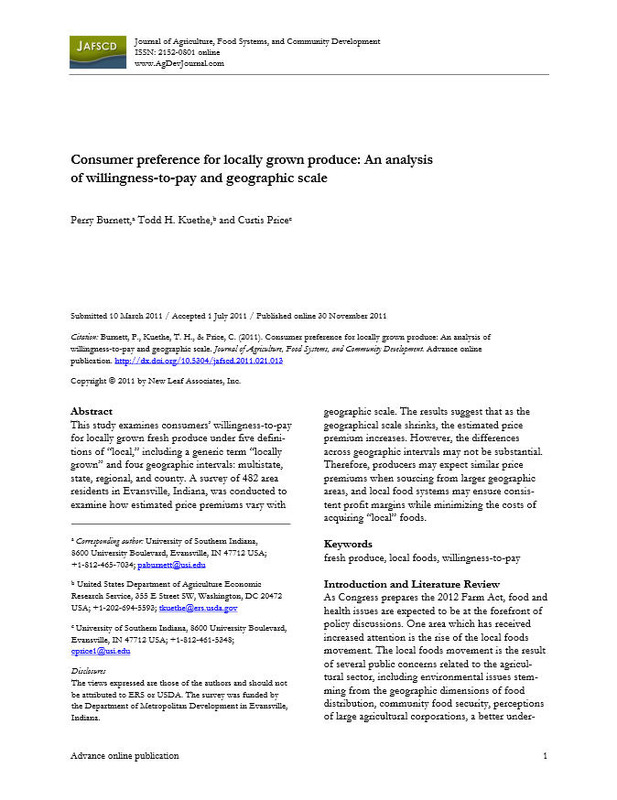Distance Between Producer and Consumer
Many definitions of local foods emphasize the concept of geographic proximity between the people who produce the food and the people who consume it.
Perhaps the clearest definition of local foods in terms of spatial distance comes from the 2008 Farm Bill:
The term 'locally or regionally produced agricultural food product' means any agricultural food product that is raised, produced, and distributed in--
(I) the locality or region in which the final product is marketed, so that the total distance that the product is transported is less than 400 miles from the origin of the product; or;
(II) the State in which the product is produced.
Food, Conservation, and Energy Act of 2008, Pub. L. 110-246, 122 Stat. 1929
The Food Safety Modernization Act uses a slightly smaller area of proximity when it refers to producers that are located 275 miles or less from their customers, or within the same state:
...(4) Definitions.--In this subsection:
(A) Affiliate.--The term `affiliate' means any facility that controls, is controlled by, or is under common control with another facility.
(B) Qualified end-user.--The term `qualified end-user', with respect to a food, means--
(i) the consumer of the food; or
(ii) a restaurant or retail food establishment (as those terms are defined by the Secretary for purposes of section 415) that--
(I) is located--
(aa) in the same State as the qualified facility that sold the food to such restaurant or establishment; or
(bb) not more than 275 miles from such facility; and
(II) is purchasing the food for sale directly to consumers at such restaurant or retail food establishment.
Food Safety Modernization Act, Pub. L. 111-353, 124 Stat. 3893
As part of the Farm to School Census, the Food and Nutrition Service of the USDA asked the school districts who participated in the Farm to School program this question: "How Does Your District Define Local?" The responses from over 9,000 school districts are summarized in the graphic shown below. (The full overview of the Farm to School Census is here).
Farm to School Census Results: "How Does Your District Define Local?"
Summary of Results:
1 day's drive: 2%
50 miles: 21%
100 miles: 13%
200 miles: 6%
Within the state: 26%
Within the region: 10%
Another definition: 5%
A third conception of locality as a measure of geographic distance is captured by the term, "locality food." This is sometimes applied to groups of foods marketed by their identity as products of a given U.S. State.
Local Food Systems: Concepts, Impacts, and Issues. Martinez, S., et al. (2010). U.S. Department of Agriculture. Economic Research Service
"Geographic proximity considerations have led to some controversy as to whether State-funded branding programs, which are aimed at promoting or identifying State-produced agricultural products, are part of the local food system. While some studies also include State-branded products as a type of local food product (Jekanowski, et al., 2000), other studies consider State labels not to be a good proxy for local food (Zepeda and Li, 2006). This is because consumers generally define 'local' in terms smaller than their State, and many State-branding programs target consumers in other States, or perhaps internationally. For example, the Florida Department of Agriculture recently partnered with a supermarket chain in Ireland to promote the State’s strawberries as part of its 'Fresh from Florida' marketing campaign. Foods that have a brand associated with a particular locality or region, but serve largely external markets, are sometimes referred to as “locality foods” to distinguish from local foods (Hughes et al., 2007)." , p. 3-4
A 2011 study of Indiana consumers found that differing conceptions of locality (defined by geographic distance between producer and consumer) affected the amount of money they would be willing to pay for "local" produce:
Consumer Preference for Locally Grown Produce: An Analysis of Willingness-To-Pay and Geographic Scale. (2011). Burnett, P., Kuethe, T.H., and Price, C. Journal of Agriculture, Food Systems, and Community Development, 2(1), p. 1
"This study examines consumers' willingness-to-pay for locally grown fresh produce under five definitions of 'local,' including a generic term 'locally grown' and four geographic intervals: multistate, state, regional, and county. A survey of 482 area residents in Evansville, Indiana, was conducted to examine how estimated price premiums vary with geographic scale. The results suggest that as the geographical scale shrinks, the estimated price premium increases. However, the differences across geographic intervals may not be substantial. Therefore, producers may expect similar price premiums when sourcing from larger geographic areas, and local food systems may ensure consistent profit margins while minimizing the costs of acquiring 'local' foods."
 An official website of the United States government.
An official website of the United States government.




